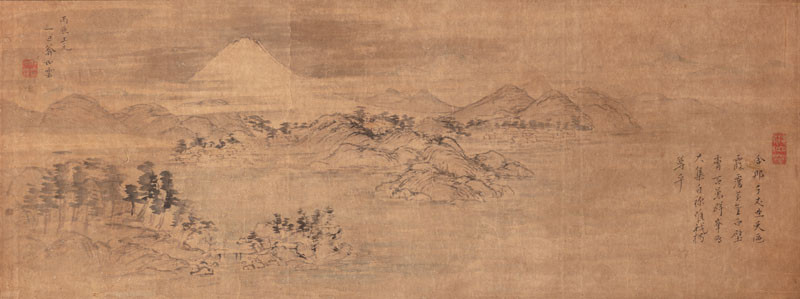
The scroll is signed “one-day hermit Joun” (Ikka an Joun) and bears a vermilion seal reading “one-day hermit” (Ikka an). It is dated the fifteenth day of the first month of the Year of the Fiery Dragon (hinoe tatsu jōgen). Sacred Mount Fuji was depicted since the Middle Ages in the Heian period (794–1185) as a certain iconographic type characterized especially by a triple peak (sanbo - kei). The view of Fuji overlooks the well-known coastal landscape in Miho no Matsubara with its typical pine grove in Suruga Bay not far from today’s city of Kiyomizu in the Shizuoka Prefecture. From there, we can see the mountain from the south-west. The mount’s white landmark is surrounded by the Satta Ridge on the left and the Ashitakayama mountains on the right. The picture shows Mount Fuji behind the Satta Ridge, which can be seen in the left foreground, while the coastal landscape is on the right. The painting “Mount Fuji with the Kiyomizudera Monastery” by Sesshu – served as a model for this type of picture, as did the “Image of Mount Fuji” from 1667 by Kanō Tan’yū, though its style is different. The artist references the latter model through the element of variable white bands of clouds partly enveloping the mountain range and deepening its impressiveness, as well as through the brush technique of contourless modellation (mokkotsuhō). Although the painter based his view on actual visual experience, he depicts it after older models, i.e. it is not a plein-air sketch (fūkei shasei). Rather, the artwork evokes a literati painting in which the landscape becomes a place of contemplation and poetic inspiration. While multiple artists used the pseudonym Joun, here the most likely is the female painter Shōtō (her real name was Yamamoto Tsunamomo or Tamiko, 1757–1831). She primarily made a name for herself as a painter of flowers. Her work was probably influenced by her husband, the painter Yamamoto Kitayama (died 1812), who was active in the circle of literati painters and familiar with the style of the Akita Ranga school based on Western realistic painting. There are four verses on the scroll’s right: Set high up in heaven / the golden daybreak shines / on a white wall / surrounded by many mountain peaks / she says of herself: I, alone, am worthy of respect.
